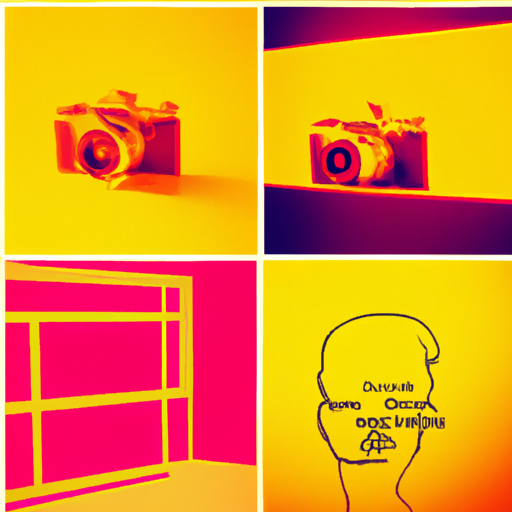
-
Table of Contents
- Exploring the Beauty of Monochromatic Design
- The Power of Color
- Creating Depth and Contrast
- Emphasizing Texture and Detail
- Case Studies: Successful Monochromatic Designs
- 1. Apple’s Product Packaging
- 2. Chanel’s Logo and Branding
- 3. National Geographic’s Magazine Covers
- Implementing Monochromatic Design
- 1. Graphic Design
- 2. Web Design
- 3. Interior Design
- Conclusion
Exploring the Beauty of Monochromatic Design

When it comes to design, there are countless approaches and styles to choose from. One style that has gained popularity in recent years is monochromatic design. This design technique involves using a single color or hue and its various shades and tints to create a visually cohesive and harmonious composition. In this article, we will delve into the world of monochromatic design, exploring its beauty, benefits, and how it can be effectively implemented in various design disciplines.
The Power of Color
Color is a powerful tool that can evoke emotions, convey messages, and create visual impact. It plays a crucial role in design, influencing how we perceive and interact with our surroundings. Monochromatic design takes advantage of this power by focusing on a single color and its variations.
By limiting the color palette, monochromatic design creates a sense of unity and simplicity. It allows designers to emphasize other elements such as form, texture, and composition, without the distraction of multiple colors. This minimalist approach can be particularly effective in creating a clean and modern aesthetic.
Creating Depth and Contrast
Contrary to popular belief, monochromatic design does not have to be flat or boring. In fact, when executed correctly, it can create depth and contrast that rival more complex color schemes. By using different shades and tints of a single color, designers can create a visually dynamic composition.
For example, imagine a monochromatic website design that uses various shades of blue. By using lighter shades for the background and darker shades for the text and other elements, the designer can create a sense of depth and hierarchy. This technique not only adds visual interest but also improves readability and user experience.
Emphasizing Texture and Detail
Monochromatic design also allows designers to emphasize texture and detail in a unique way. When there are no competing colors, the focus shifts to the textures and patterns present in the design. This can be particularly effective in industries such as fashion and interior design, where texture plays a significant role.
For instance, a monochromatic interior design scheme that uses various shades of gray can highlight the texture of different materials, such as a plush rug or a rough concrete wall. By removing the distraction of multiple colors, the designer can draw attention to the intricate details that might otherwise go unnoticed.
Case Studies: Successful Monochromatic Designs
To further illustrate the beauty and effectiveness of monochromatic design, let’s explore a few case studies of successful implementations:
1. Apple’s Product Packaging
Apple is known for its sleek and minimalist design aesthetic, and their product packaging is no exception. The company often uses monochromatic color schemes, such as white or silver, to create a sense of elegance and sophistication. By keeping the focus on the product itself, Apple’s packaging design reinforces their brand identity and creates a memorable unboxing experience.
2. Chanel’s Logo and Branding
Chanel, the iconic fashion brand, is recognized worldwide for its timeless elegance. The brand’s logo and branding materials often feature a monochromatic color scheme, typically black and white. This choice not only aligns with the brand’s classic image but also allows the focus to be on the luxurious materials and craftsmanship of their products.
3. National Geographic’s Magazine Covers
National Geographic is renowned for its stunning photography and captivating storytelling. The magazine’s covers often feature monochromatic designs that enhance the impact of the featured image. By using a single color or a limited color palette, National Geographic creates a sense of focus and intrigue, drawing readers into the stories within.
Implementing Monochromatic Design
Now that we have explored the beauty and benefits of monochromatic design, let’s discuss how it can be effectively implemented in various design disciplines:
1. Graphic Design
In graphic design, monochromatic color schemes can be used to create visually striking logos, posters, and other marketing materials. By carefully selecting shades and tints of a single color, designers can convey a specific mood or message. For example, a monochromatic red design might evoke feelings of passion and energy, while a monochromatic blue design might convey a sense of calm and tranquility.
2. Web Design
Monochromatic color schemes can also be applied to web design to create clean and modern websites. By using different shades and tints of a single color, designers can guide users’ attention and create a seamless user experience. Additionally, monochromatic designs are often more accessible for individuals with color vision deficiencies, as they rely less on color differentiation.
3. Interior Design
In interior design, monochromatic color schemes can be used to create cohesive and visually appealing spaces. By using different shades and tints of a single color, designers can create a sense of harmony and balance. This approach is particularly effective in small spaces, as it can make them appear larger and more open.
Conclusion
Monochromatic design offers a unique and visually appealing approach to various design disciplines. By focusing on a single color and its variations, designers can create visually cohesive compositions that emphasize other elements such as form, texture, and detail. From graphic design to web design and interior design, the beauty and benefits of monochromatic design are evident. So, whether you’re looking to create a sleek logo, a modern website, or a harmonious living space, consider exploring the beauty of monochromatic design.
